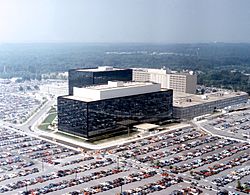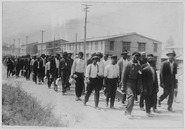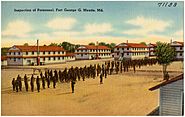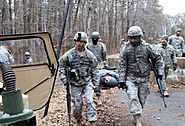Fort Meade facts for kids
Quick facts for kids Fort George G. Meade |
|
|---|---|
| Near Fort Meade, Maryland in United States | |

The National Security Agency headquarters building, a major tenant at Fort G. Meade
|
|
 |
|
|
Location in Maryland##Location in United States
|
|
| Coordinates | 39°6′25″N 76°44′35″W / 39.10694°N 76.74306°W |
| Type | US Army installation |
| Area | 5,067 acres (2,051 hectares) |
| Site information | |
| Owner | Department of Defense |
| Operator | US Army |
| Controlled by | US Army Installation Management Command (IMCOM) |
| Condition | Operational |
| Site history | |
| Built | 1917 |
| In use | 1917–present |
| Garrison information | |
| Current commander |
Colonel Michael Sapp |
Fort George G. Meade is a large United States Army base located in Maryland. It is home to many important military and government groups. These include the National Security Agency (NSA) and United States Cyber Command. The base is named after George G. Meade, a famous general from the American Civil War. He led the Army of the Potomac.
The area around the fort, called a census-designated place, has homes, schools, and offices. These facilities support the many people who work and live at Fort Meade.
Contents
History of Fort Meade
Fort Meade started as "Camp Admiral" in 1917. It was built as a training camp during World War I. The land for the camp was about 29.7 sq mi (77 km2). By 1918, it was known as Camp Meade Cantonment.
In 1928, the fort was briefly renamed Fort Leonard Wood. During this time, the army tested new vehicles and battle plans. They used these tests to improve how soldiers moved and fought.
Fort Meade in World War II
During World War II, Fort Meade was a busy place. It was used to train new soldiers. It also held prisoners of war. The fort was a temporary home for about 384 people from Japan, Germany, and Italy. These people were living in the U.S. but were arrested because they were thought to be a threat.
After the war, in 1947, the Second United States Army moved its headquarters to Fort Meade. Then, in 1957, the National Security Agency (NSA) made the fort its main home.
Cold War Air Defense
From the 1950s to the 1970s, Fort Meade played a key role in air defense. It had special radar equipment to track planes. It also had some of the first Nike Ajax missiles. These were surface-to-air missiles used to shoot down enemy aircraft.
In 1962, during the Cuban Missile Crisis, soldiers from Fort Meade were sent to Florida. They helped protect the area with their MIM-23 Hawk missiles.
Fort Meade Grows
Fort Meade has grown a lot over the years. In 1995, the Defense Information School moved to the fort. This school teaches people how to work in public affairs and media for the military.
In 2005, a plan called Base Realignment and Closure, 2005 helped Fort Meade grow even more. It added 5,700 new jobs to the base. Today, Fort Meade has over 54,000 employees. This makes it the largest employer in Maryland. It is also the second largest Army base by employee count.
Environmental Care
Fort Meade works to protect the environment. In 2007, the U.S. Environmental Protection Agency asked the fort to check 14 areas for pollution. The Army is now taking steps to limit any environmental damage.
Key Agencies at Fort Meade
In 2009, United States Cyber Command was created at Fort Meade. This command helps protect the nation from cyber attacks. In 2011, the Defense Information Systems Agency (DISA) also moved its headquarters to the fort. DISA provides information technology and communication support for the military.
Defense Information School
The Defense Information School (DINFOS) is a special school at Fort Meade. It teaches military members and civilians how to be journalists, broadcasters, and visual information specialists. It combines training from different fields like photography and public affairs. This helps ensure that all military communication is clear and effective.
Security Events
Fort Meade is a secure military base. There have been a few security incidents over the years. In 2015, a person tried to drive an SUV through a restricted entrance. Officers stopped the vehicle. In 2018, another person rammed an SUV into a barricade near an entry gate. In both cases, authorities quickly handled the situations. The NSA announced that there was "no ongoing security or safety threat" after these events.
Geography
Fort Meade is located in Maryland, between Washington, D.C. and Baltimore. The Baltimore–Washington Parkway runs along its western side. It is about 5 miles (8.0 km) east of Interstate 95. Nearby towns include Odenton, Columbia, and Laurel.
Units Based at Fort Meade
Many important military and government groups are based at Fort George G. Meade.
United States Army
United States Marines
United States Air Force
Department of Defense
Other Government Agencies
|
Library of Congress Storage
Fort Meade is also used by the Library of Congress to store many of its valuable collections. In 1994, 100 acres (40 ha) of land at Fort Meade was given to the U.S. Congress. This was to create more storage space for the Library of Congress and other government groups.
Special storage buildings, called "Phased Storage Modules," have been built. These buildings are designed to keep books, maps, photos, and other items safe. They protect the collections from damage and help them last a long time. Several modules have been completed, and more are planned if needed.
Museums
The Fort George G. Meade Museum used to display historical items from the base. These included old uniforms, military gear, and even some vehicles. The museum had tanks like the Renault FT and the M4A3E8 Sherman. It also had an M113 armored personnel carrier and a Nike Ajax missile.
In 2018, the museum closed. Its artifacts were moved to the National Museum of the United States Army. This new museum is located in Fort Belvoir, Virginia.
Transportation
Since 2005, the NSA has offered a shuttle service. This shuttle takes people from the Odenton station of MARC to the NSA Visitor Control Center at Fort Meade. In 2009, the U.S. Army started a similar shuttle. This service takes people from the Odenton station to the Army section of the fort. It helps employees and visitors get to the base easily.
Housing Concerns
In 2019, military leaders visited Fort Meade to address concerns about housing. Some families living on the base had problems with their homes. There were reports of lead and asbestos exposure. The Army leaders met with the company that manages the housing. They are working to make sure all homes on the base are safe for military families.
Gallery
See also
 In Spanish: Fort George G. Meade para niños
In Spanish: Fort George G. Meade para niños









